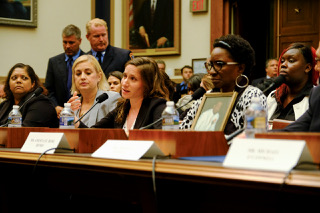StuyHealth: ‘Even Now It’s Not Over for Us…’
Like all Stuyvesant students who were at school when airplanes hit the World Trade Center towers, Lila Nordstrom ’02 felt things would never be the same after that day. But it was over four years later that it started to sink in for her exactly how true that feeling was.
“I was just graduating college when the news broke that James Zadroga’s death had been definitively linked to 9/11,” Nordstrom said. The NYPD officer was the first whose fatal respiratory disease was attributed to exposure to chemicals at the World Trade Center site. “For me it was a moment where I thought, Oh God, this is going to catch up with us. Even now it’s not over for us.”

At this time, in the middle of 2006, Facebook was taking off as a way to make connecting with friends and former classmates easier than ever before. Nordstrom started collecting signatures from other Stuy alumni, and from there came an idea of an organization to help people who live, work, and study in TriBeCa gain access to the benefits being made available for people impacted by the events of 9/11, the subsequent recovery, and clean-up.
The organization, named StuyHealth, connects the benefits made possible by the World Trade Center Health Program and the Victim Compensation Fund to people who were in lower Manhattan on the day of the attacks and in the months that followed while the area was being cleaned up.
“I think there’s a mindset that you have to be dying of cancer to get any resources,” Nordstrom said. “A lot of people hesitate to seek help if they’re not seriously ill. We’re trying to dispel that, because this program helps people who have chronic illnesses that might not be serious but are expensive to treat.”
Some of the most commonly diagnosed illnesses that qualify for help under the WTC Health Program are asthma, gastroesophageal reflux disease (GERD), rhinosinusitis, and post-traumatic stress disorder (PTSD). These are common, non-lethal illnesses that might be caused or aggravated by proximity to lower Manhattan during the clean-up process or the attacks themselves.
“For us, 9/11 is the cause of this health and environmental crisis, which is not discussed at the national level the way policy and terrorism are discussed. There’s an information gap,” Nordstrom said. “For years we were ‘gaslit’ about the physical health implications from 9/11. But I get a lot of value out of these programs as someone who has the most commonly diagnosed things.”
“It comes up in surprising moments in your life, and it comes up forever."
Getting information out to the world, let alone getting funding for the health problems that impacted the local community, hasn’t been easy. “We had something tragic happen, but we’re often told as a community that we don’t have the best story because we weren’t first responders. No one wants to talk about the people who live or go to school in lower Manhattan, they want to talk about the heroes,” Nordstrom said. “People know first responders went through this crisis, but they don’t realize that students and residents were sent back to the neighborhood when the air wasn’t safe for them to be there.”
PTSD and other mental health issues caused by 9/11 are especially complicated, particularly in a culture that still struggles with stigma over mental health illnesses but also constantly talks about terrorism and 9/11.
“It comes up in surprising moments in your life, and it comes up forever,” Nordstrom said. She talked about answering the phones at StuyHealth and talking to people who only started to show symptoms of anxiety and PTSD around 9/11 recently, even though the events themselves happened almost 18 years ago. “These events, they’re constantly in the national discussion, constantly being re-lived, constantly being misappropriated. It’s not unusual for your mind to shut that down for years. It’s not something where, if you didn’t get it right in that moment, that doesn’t mean it’s not legitimate.”
HBO Documentary Films recently made a documentary about the role that Stuyvesant High School, the people and the building, played on 9/11 and in the days, weeks and months afterward. The film “In the Shadow of the Towers: Stuyvesant High on 9/11,” will premiere in the theater at Stuyvesant High School at 4 p.m. Tuesday, Sept. 10 with a panel discussion, including some of the Stuyvesant alumni featured in the film, to follow.
The premiere is produced by HBO. The film is about 30 minutes long and will air on HBO at 9 p.m. Wednesday, Sept. 11.
This film contains graphic content and may be disturbing to some audience members.
If you think you qualify for benefits under the WTC Health Program, please reach out.
Get Help